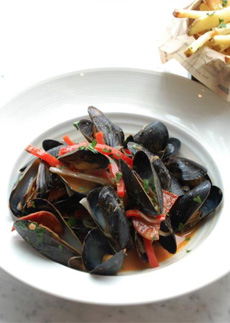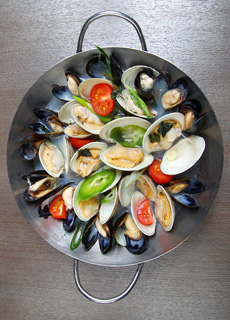TIP OF THE DAY: Steamed Mussels (Moules Marinière)
 A classic bowl of mussels. Photo courtesy Duplex On Third | Los Angeles. |
Recently we joined a group for dinner at a French bistro. Others dug into rilletes and onion soup hidden under a heavy layer of Gruyère, cassoulet and steak frites. We, still feeling guilty about all the Easter candy consumed pre- and post-holiday, opted for the steak tartare and moules marinière, steamed mussels. As we devoured mussel after plump mussel, we pondered: This is such an easy to make, better-for-you, delicious dish. Why do we no longer make it at home? It turns out that our chief obstacle, sand, no longer exists. Wild mussels can be quite sandy, requiring soaking after soaking. We lacked the patience for it, especially when after all the soaking we still bit into grains of sand. But these days, most mussels don’t grow on the ocean floor; they’re farm raised, in bags that hang vertically on ropes above the ocean floor. They’re pretty sand-free. (Yay!) All you need is a good fish store; and you can even find quality frozen mussels that do the trick (check out VitalChoice.com—no thawing required, just pop them in the pot). |
|
|
The two most popular recipes hail from France and Italy: After you’re comfortable with the basic recipe, you can go all out with seasonings. Flex Mussels in New York City serves 21 different recipes, from the classics to cuisine-specific riffs from Indian (cinnamon, curry, garlic, star anise, white wine) to Thai (coconut broth, coriander, curry, kaffir lime, lemongrass, lime, ginger, garlic). If you’re old enough to remember Alice’s Restaurant—the hit song, which begat the feature film and cookbook—Alice liked to vary her recipes. On steamed mussels, she commented: “Tomatoes and oregano make it Italian; wine and tarragon make it French. Sour cream makes it Russian; lemon and cinnamon make it Greek. Soy sauce makes it Chinese; garlic makes it good.” Now, let’s get ready to make mussels! HOW TO BUY & CLEAN MUSSELS For dinner, figure two-thirds of a pound of mussels in the shell per person—more for hearty eaters. Leftover mussels are delicious the next day, either warmed or chilled with a green salad and vinaigrette. Mussels and other some other bivavles (clams, cockles, oysters) are sold live, kept cold on ice. Unlike other seafood, once a bivalve is no longer alive, the flesh decomposes quickly. Buy mussels with moist shells (not dry-looking) that are tightly closed, with no external blemishes. Western mussels have black shells. You may find New Zealand mussels, which have green shells and tend to be meatier. Even if you buy farm-raised mussels, you may want still want to go through the classic rinsing process.
Most people who cook bivalves know to discard these: They may be dead. But here’s a trick: Tap them firmly a few times with a spoon or other implement. If they’re alive, they will slowly close their shells. If there’s no motion, consider them dead and toss them in the trash. And definitely toss any mussels with cracked shells prior to cooking. Bacteria may have entered through the crack. What if you’re not going to cook the mussels immediately? You can keep the mussels for a few days if you place them in a bowl or other container in the coldest part of the refrigerator (generally the rear of the bottom shelf). First line the bowl with a plastic storage bag filled with ice resting on top. Cover with a damp paper towel. |
||
|
RECIPE: MOULES MARINIÈRE
Ingredients For 6 Servings 1. COMBINE the first six ingredients (through the cayenne) in a large pot, and simmer until reduced to a half cup. Strain into a large pot and add the mussels. |
 Spicy mussels. If you like heat, add sliced jalapeno or crushed red pepper flakes—or make Mussels Fra Diavolo. Photo courtesy Barnjoon | NYC. |
|
|
2. COOK 5 to 10 minutes or until the shells open, shaking the pot from time to time. With a slotted spoon, remove the mussels to individual soup bowls (ideally, large and shallow), retaining the liquid in the pot. 3. MAKE the sauce: Add the butter and optional salt to the liquid in the mussels pot. MUSSELS FRA DIAVOLO Fra diavolo means “brother devil” in Italian, a nickname given to a Neapolitan guerrilla leader in his feisty childhood. The spicy-hot recipe was named in his honor. (The Italian word for mussels is cozza, plural cozze, pronounced CUT-sah and CUT-say).) The recipe features marinara sauce (you can use tomato paste and tomato purée) and heat from crushed red pepper. Here’s a recipe from Chef Jasper White. In Italy, it is often served atop a dish of linguine.
|
||


